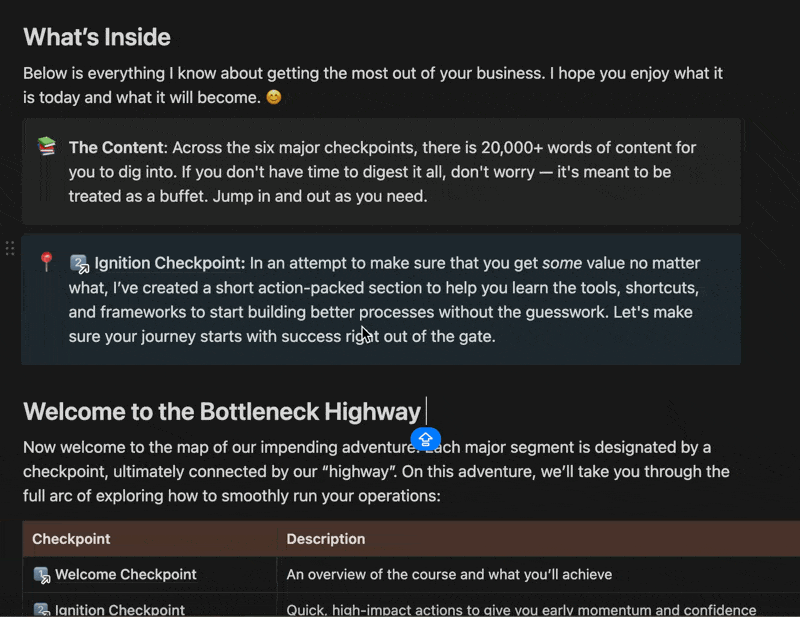Not subscribed? Sign up to get it in your inbox every week.

⚙ Hi {{first_name_tally|Operator}},
We’ve run 60+ demo calls since last Monday; turns out soloprenuers, freelancers, and consultants want to use our tool.
But… my mouth hurts from talking. And the vein in my forehead is bulging. And I now have too many ideas based on everyone thinking that we’ve basically built Slack for video meetings.
Please don’t schedule anymore demo calls. I beg you.
- Rameel
P.S My technical co-founder is making me put our calendar link here. Please don’t schedule unless you really wanna make me miserable

PRESENTED BY THE BOTTLENECK
Stop Being the Team’s Firefighter. Start Acting Like Their Future COO
Your calendar is full. Your brain is fried. And somehow, your work still flies under the radar.
Here’s the truth: You don’t get promoted for working more. You get promoted for fixing what’s broken.
Bottleneck Breakers is the system I used to:
– Trim 20 hours of busywork a week
– Fix the stuff that actually moved the needle
– And earn a COO title before I turned 30
🧠 No video lectures. Just drop-in systems that make you undeniable when promotion season hits.
Thanks to our sponsors who keep this email free. Interested in sponsoring these emails? See our partnership options here

Why homogeneous teams can't see the problems their shared assumptions create
Insight from… ME!
I was the problem employee at Uber Freight.
While my fellow account managers were focused on keeping clients happy, I kept asking for money.
Detention charges, layover fees, accessorial payments—all the industry-standard add-ons that everyone else was quietly waiving to avoid awkward conversations.
Turns out, being the annoying guy who actually collected what we were owed revealed a $10+ million problem hiding in plain sight.
The Tea Time Revelation
Uber Freight had this tradition called "tea time"—10-12 account managers would pile into a conference room after lunch, drink tea for 20 minutes, and just talk shop.
One day I mentioned my profit margins and asked how everyone else thought about requesting accessorials. Dead silence. Then: "Why are you doing this?"
That's when I realized I wasn't the problem employee. I was the only one immune to the cultural groupthink.
This is the hidden cost of culture fit: when everyone thinks alike, no one thinks very much. Homogeneous teams reinforce each other's assumptions instead of challenging them.
40% of workers report their jobs as extremely stressful, and I guarantee a huge chunk of that stress comes from this exact pattern: Everyone assumes someone else owns the thing that's actually broken.
The SQL Query That Changed Everything
I pulled a query comparing account performance across the team. My margins were 3-4 percentage points higher than everyone else's.
Not because I was better at selling—because I was the only one collecting industry-standard fees.
When I showed my manager, he got it immediately. "I knew this anecdotally," he said, "but I didn't know how to prove it."
Here's what we discovered: Account managers weren't requesting accessorials because they were terrified of losing clients.
Coming from investment banking, I didn't have that fear—I just saw money being left on the table. But everyone else came from trucking, where relationships trump everything.
The real problem wasn't training. It was fear disguised as a training problem.
The Bureaucratic Resistance to Cognitive Diversity
Fixing this took seven months of bureaucratic hell—not because the solution was complex, but because homogeneous leadership teams resist insights that challenge their shared assumptions.
Even after showing them the revenue leak, they wanted more analysis. "Are you sure this is worth dedicating resources to?" they asked, staring at millions in lost revenue.
Meanwhile, we had to retrain clients who'd gotten used to free money.
This was peak Uber chaos—Travis Kalanick had just been replaced, and the company was shifting from "growth at all costs" to actually caring about profitability.
Conversations went like this:
"We're implementing industry-standard charges. If that means losing your business, we understand. Come back when you realize we still offer competitive pricing with better service."
Some clients pushed back hard. But here's the thing about industry standards—they're standard for a reason.
The Cultural Blind Spot Audit
This isn't just about fear or training. It's about homogeneous teams creating systematic operational blind spots.
Here's how to spot when cultural alignment is actually hurting your operations:
Red Flag #1: Everyone on your team comes from the same industry background
What You're Missing: Outsider perspectives that question "how we've always done it"
Red Flag #2: Your team proudly talks about "culture fit" during hiring
What You're Missing: Cognitive diversity that catches different failure modes
Red Flag #3: Problems keep recurring despite "obvious" solutions
What You're Missing: The solutions aren't obvious—they're just obvious to your cultural echo chamber
The Uber Freight team wasn't bad at their jobs. They were excellent at trucking culture, where relationships matter most.
But that same strength created a million-dollar blind spot around revenue capture.
Your Cultural Diversity Diagnostic
Next time you're facing a recurring issue, audit for cognitive monoculture:
Map team backgrounds - Do your operators all come from the same industry/function?
Find the outlier performance - Who's getting different results with the same process?
Analyze the difference - What cultural assumption is the outlier not making?
Systematize the outlier insight - How do you capture their perspective organizationally?
Most "operational problems" are actually cultural blind spots that homogeneous teams can't see.
The Uncomfortable Truth
That Uber Freight fix drove 3-4% additional top-line revenue.
Not because we hired better people or built better systems, but because we accidentally had cognitive diversity on a culturally homogeneous team.
Your recurring problems are predictable result of hiring for culture fit instead of cognitive diversity.
The teams that "work well together" often think too similarly to catch each other's blind spots.
Sometimes the "problem employee" who doesn't fit your culture is actually the one seeing what everyone else misses.
Stop optimizing for culture fit. Start optimizing for cognitive diversity.

What you think of today's newsletter?




